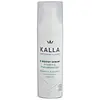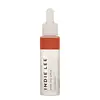What's inside
What's inside
 Key Ingredients
Key Ingredients

 Benefits
Benefits

 Concerns
Concerns

No concerns
 Ingredients Side-by-side
Ingredients Side-by-side

Water
Skin ConditioningGlycerin
HumectantAscorbyl Glucoside
AntioxidantXanthan Gum
EmulsifyingBiosaccharide Gum-1
HumectantSodium Benzoate
MaskingPotassium Sorbate
PreservativeLysolecithin
EmulsifyingSclerotium Gum
Emulsion StabilisingSodium Hyaluronate
HumectantPullulan
Rubus Chamaemorus Fruit Extract
AntioxidantGlyceryl Caprylate
EmollientSodium Anisate
AntimicrobialSodium Levulinate
Skin ConditioningCalluna Vulgaris Flower Extract
Skin ConditioningWater
Skin ConditioningPropanediol
SolventRosa Damascena Flower Water
MaskingLeuconostoc/Radish Root Ferment Filtrate
AntimicrobialNiacinamide
SmoothingHydroxyethylcellulose
Emulsion StabilisingGlycerin
HumectantPotassium Sorbate
PreservativeCitric Acid
BufferingCentella Asiatica Meristem Cell Culture
AntioxidantSodium Gluconate
Skin ConditioningSodium Acetate
BufferingCellulose
AbsorbentMalus Domestica Fruit Cell Culture Extract
Skin ConditioningSodium Hyaluronate
HumectantXanthan Gum
EmulsifyingEchinacea Angustifolia Meristem Cell Culture
Skin ConditioningSodium Benzoate
MaskingWater, Propanediol, Rosa Damascena Flower Water, Leuconostoc/Radish Root Ferment Filtrate, Niacinamide, Hydroxyethylcellulose, Glycerin, Potassium Sorbate, Citric Acid, Centella Asiatica Meristem Cell Culture, Sodium Gluconate, Sodium Acetate, Cellulose, Malus Domestica Fruit Cell Culture Extract, Sodium Hyaluronate, Xanthan Gum, Echinacea Angustifolia Meristem Cell Culture, Sodium Benzoate
Ingredients Explained
These ingredients are found in both products.
Ingredients higher up in an ingredient list are typically present in a larger amount.
Glycerin is already naturally found in your skin. It helps moisturize and protect your skin.
A study from 2016 found glycerin to be more effective as a humectant than AHAs and hyaluronic acid.
As a humectant, it helps the skin stay hydrated by pulling moisture to your skin. The low molecular weight of glycerin allows it to pull moisture into the deeper layers of your skin.
Hydrated skin improves your skin barrier; Your skin barrier helps protect against irritants and bacteria.
Glycerin has also been found to have antimicrobial and antiviral properties. Due to these properties, glycerin is often used in wound and burn treatments.
In cosmetics, glycerin is usually derived from plants such as soybean or palm. However, it can also be sourced from animals, such as tallow or animal fat.
This ingredient is organic, colorless, odorless, and non-toxic.
Glycerin is the name for this ingredient in American English. British English uses Glycerol/Glycerine.
Learn more about GlycerinPotassium Sorbate is a preservative used to prevent yeast and mold in products. It is commonly found in both cosmetic and food products.
This ingredient comes from potassium salt derived from sorbic acid. Sorbic acid is a natural antibiotic and effective against fungus.
Both potassium sorbate and sorbic acid can be found in baked goods, cheeses, dried meats, dried fruit, ice cream, pickles, wine, yogurt, and more.
You'll often find this ingredient used with other preservatives.
Learn more about Potassium SorbateSodium Benzoate is a preservative. It's used in both cosmetic and food products to inhibit the growth of mold and bacteria. It is typically produced synthetically.
Both the US FDA and EU Health Committee have approved the use of sodium benzoate. In the US, levels of 0.1% (of the total product) are allowed.
Sodium benzoate works as a preservative by inhibiting the growth of bacteria inside of cells. It prevents the cell from fermenting a type of sugar using an enzyme called phosphofructokinase.
It is the salt of benzoic acid. Foods containing sodium benzoate include soda, salad dressings, condiments, fruit juices, wines, and snack foods.
Studies for using ascorbic acid and sodium benzoate in cosmetics are lacking, especially in skincare routines with multiple steps.
We always recommend speaking with a professional, such as a dermatologist, if you have any concerns.
Learn more about Sodium BenzoateSodium Hyaluronate is hyaluronic acid's salt form. It is commonly derived from the sodium salt of hyaluronic acid.
Like hyaluronic acid, it is great at holding water and acts as a humectant. This makes it a great skin hydrating ingredient.
Sodium Hyaluronate is naturally occurring in our bodies and is mostly found in eye fluid and joints.
These are some other common types of Hyaluronic Acid:
Learn more about Sodium HyaluronateWater. It's the most common cosmetic ingredient of all. You'll usually see it at the top of ingredient lists, meaning that it makes up the largest part of the product.
So why is it so popular? Water most often acts as a solvent - this means that it helps dissolve other ingredients into the formulation.
You'll also recognize water as that liquid we all need to stay alive. If you see this, drink a glass of water. Stay hydrated!
Learn more about WaterXanthan gum is used as a stabilizer and thickener within cosmetic products. It helps give products a sticky, thick feeling - preventing them from being too runny.
On the technical side of things, xanthan gum is a polysaccharide - a combination consisting of multiple sugar molecules bonded together.
Xanthan gum is a pretty common and great ingredient. It is a natural, non-toxic, non-irritating ingredient that is also commonly used in food products.
Learn more about Xanthan Gum